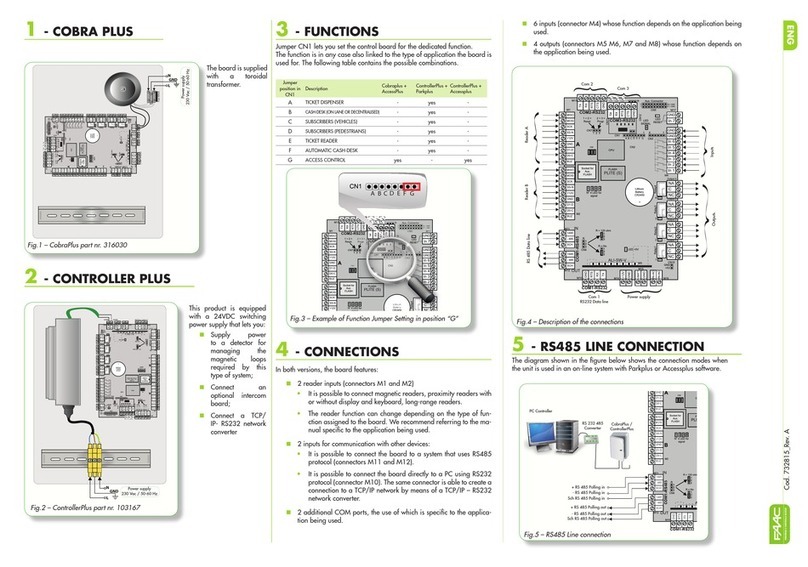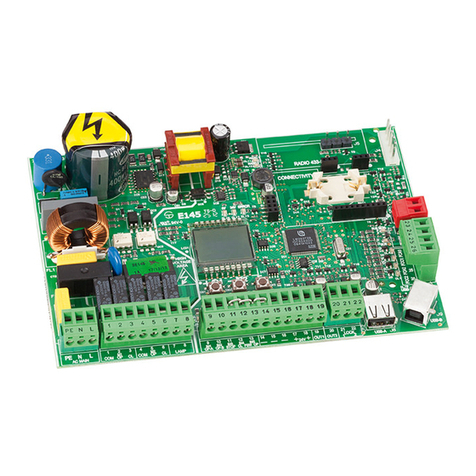
AVVERTENZE PER L’INSTALLATORE
OBBLIGHI GENERALI PER LA SICUREZZA
1) ATTENZIONE! È importante per la sicurezza delle persone seguire
attentamente tutte le istruzioni. Una errata installazione o un errato uso
del prodotto può portare a gravi danni alle persone.
2) Leggere attentamente le istruzioni prima di iniziare l’installazione del
prodotto.
3) I materiali dell’imballaggio (plastica,polistirolo,ecc.) non devono
essere lasciati alla portata dei bambini in quanto potenziali fonti di
pericolo.
4) Conservare le istruzioni per riferimenti futuri.
5) Questo prodotto è stato progettato e costruito esclusivamente per
l’utilizzo indicato in questa documentazione. Qualsiasi altro utilizzo
non espressamente indicato potrebbe pregiudicare l’integrità del
prodotto e/o rappresentare fonte di pericolo.
6) FAAC declina qualsiasi responsabilità derivata dall’uso improprio o
diverso da quello per cui l’automatismo è destinato.
7) Non installare l’apparecchio in atmosfera esplosiva: la presenza di
gas o fumi infiammabili costituisce un grave pericolo per la sicurez-
za.
8) Gli elementi costruttivi meccanici devono essere in accordo con
quanto stabilito dalle Normative UNI 8612, CEN pr EN 12604 e CEN pr
EN 12605.
Per i Paesi extra-CEE, oltre ai riferimenti normativi nazionali, per
ottenere un livello di sicurezza adeguato, devono essere seguite le
Norme sopra riportate.
9) FAAC non è responsabile dell’inosservanza della Buona Tecnica
nella costruzione delle chiusure da motorizzare,nonchè delle
deformazioni che dovessero intervenire nell’utilizzo.
10) L’installazione deve essere effettuata nell’osservanza delle Norme
UNI8612, CEN pr EN 12453 e CEN pr EN 12635.Il livello di sicurezza
dell’automazione deve essere C+E.
11) Prima di effettuare qualsiasi intervento sull’impianto, togliere l’alimen-
tazione elettrica.
12) Prevedere sulla rete di alimentazione dell’automazione un interrutto-
re onnipolare con distanza d’apertura dei contatti uguale o superio-
re a 3mm. È consigliabile l’uso di un magnetotermico da 6A con
interruzione onnipolare.
13) Verificare che a monte dell’impianto vi sia un interruttore differenzia-
le con soglia da 0,03A.
14) Verificare che l’impianto di terra sia realizzato a regola d’arte e
collegarvi le parti metalliche della chiusura. Collegare inoltre a terra
il filo Giallo/Verde dell’automatismo.
15) L’automazione dispone di una sicurezza intrinseca antischiaccia-
mento costituita da un controllo di coppia che deve comunque
essere sempre accompagnato ad altri dispositivi di sicurezza.
16) I dispositivi di sicurezza (Es.: fotocellule,coste sensibili,ecc...) per-
mettono di proteggere eventuali aree di pericolo da Rischi mecca-
nici di movimento, come ad Es. schiacciamento, convogliamento,
cesoiamento.
17) Per ogni impianto è indispensabile l’utilizzo di almeno una segnala-
zione luminosa, nonchè di un cartello di segnalazione fissato ade-
guatamente sulla struttura dell’infisso, oltre ai dispositivi citati al punto
“16”.
18) FAAC declina ogni responsabilità ai fini della sicurezza e del buon
funzionamento dell’automazione in caso vengano utilizzati compo-
nenti dell’impianto non di produzione FAAC.
19) Per la manutenzione utilizzare esclusivamente parti originali FAAC.
20) Non eseguire alcuna modifica sui componenti facenti parte del
sistema d’automazione.
21) L’installatore deve fornire tutte le informazioni relative al funziona-
mento manuale del sistema in caso di emergenza e consegnare
all’utilizzatore dell’impianto la "Guida per l'Utente" allegata al prodot-
to.
22) Non permettere ai bambini o persone di sostare nelle vicinanze del
prodotto durante il funzionamento.
23) Tenere fuori dalla portata dei bambini radiocomandi o qualsiasi
altro datore di impulso, per evitare che l’automazione possa essere
azionata involontariamente.
24) L’utilizzatore deve astenersi da qualsiasi tentativo di riparazione o
d’intervento diretto e rivolgersi solo a personale qualificato.
25) Tutto quello che non è previsto espressamente in queste istruzioni non
è permesso
IMPORTANT NOTICE FOR THE INSTALLER
GENERAL SAFETY REGULATIONS
1) WARNING! FAAC strongly recommends to follow these instructions
literally for the safety of persons. Improper installation or misuse of the
product will cause very serious damages to persons.
2) Packaging material (plastic, polystyrene etc.) is a potential hazard
and must be kept out of reach of children.
3) Read the instructions carefully before installing the product.
4) Keep these instructions for future reference.
5) This product has been designed and manufactured only for the use
stated in this manual. Any other use not expressly set forth will affect
the reliability of the product and/or could be source of hazard.
6) FAAC cannot be held responsible for any damage caused by
improper use or different from the use for which the automation
system is destined to.
7) Do not use this device in areas subject to explosion: the presence of
flammable gas or fumes is a serious hazard.
8) Mechanical constructive elements must comply with UNI8612, CEN
pr EN 12604 and CEN pr EN 12605 standards.
Countries outside the EC shall follow the regulations above besides
their national normative references in order to offer the utmost
safety.
9) FAAC cannot be held responsible for failure to observe technical
standards in the construction of gates and doors, or for any
deformation of the gates which may occur during use.
10) Installation must comply with UNI8612, CEN pr 12453 and CEN pr EN
12635. The degree of safety of the automation must be C
+ E.
11) Before carrying out any operations, turn off the system’s main switch.
12) An omnipower switch shall be provided for the installation with an
opening distance of the contacts of 3 mm or more. Alternatively,
use a 6A thermomagnetic breaker with multi-pole switching.
13) Ensure that there is a differential switch up-line of the electrical
system, with a trip threshold of 0.03A.
14) Check that the earthing plant is in perfect condition and connect it
to the metallic parts. Also earth the yellow/green wire of the operator.
15) The automation is fitted with an anti-crush safety system that is a
torque control device. In any case, further safety devices shall be
installed.
16) The safety devices (e.g. photocells, safety edges, etc.) protect
areas wherethere is a mechanical movement hazard, e.g. crushing,
entrapment and cutting.
17) Each installation must be fitted with at least one fashing light as well
as a warning plate suitably fixed to the gate, besides the safety
devices as per point 16. above.
18) FAAC cannot be held responsible regarding safety and correct
functioning of the automation in the event that parts other than FAAC
original parts are used.
19) Use only FAAC original spare parts for maintenance operations.
20) Do not carry out any modifications to automation components.
21) The installer must supply all information regarding manual operation
of the system in the event of an emergency and provide the end-
user with the "End-user Guide" attached to the product.
22) Keep out of persons when the product is in operation.
23) Keep out of reach of children the remote radio controls and any
control devices. The automation could be operated unintentionally.
24) The end-user must avoid any attempt to repair or adjust the automation
personally. These operations must be carried out exclusively by
qualified personnel.
25) What is not explicitly stated in these instructions is not permitted.
CONSIGNES POUR L'INSTALLATEUR
RÈGLES DE SÉCURITÉ
1) ATTENTION! Il est important pour la sécurité des personnes de lire
attentivement toute la notice d’instructions. Une mauvaise installation
et/ou utilisation du produit peut faire courir de graves risques aux
personnes.
2) Lire attentivement les instructions avant de commencer le montage
de l’automatisme
3) Tenir à l’écart des enfants tous les matériaux d’emballage (plastique,
polystyrène, etc...).
4) Toujours conserver la notice pour toute consultation future.
5) Cet automatisme a été conçu exclusivement pour l’utilisation
indiquée sur la présente notice. Tout autre utilisation pourrait
compromettre son efficacité et/ou représenter une source de
danger.
6) FAAC décline toute responsabilité en cas d’utilisation impropre ou
autre que celle pour laquelle l’automatisme est destiné.
7) Ne pas installer l’automatisme en atmosphère explosive: la présence
de gaz ou de fumées inflammables représente un grave risque
pour la sécurité.
8) Les parties mécaniques de construction de l’automatisme doivent
satisfaire les exigences essentielles des normes UNI8612, EN pr EN
12604 et CEN pr EN 12605.
Dans les pays ne faisant par partie de la CEE, outre le respect à la
législation nationale, l’installateur doit se conformer aux normes ci-
dessus pour garantir un niveau de sécurité adéquat.
9) FAAC ne saurait être tenu pour responsable de l'inobservation des
règles de l'art dans la construction des fermetures à motoriser ni de
leurs détériorations pendant leur durée de fonctionnement.
10) L’installation doit être réalisée conformément aux normes UNI8612,
CEN pr EN 12453 et CEN pr EN 12635. Le niveau de sécurité de
l’automatisme doit être C+E.
11) Avant toute intervention sur l’installation, couper l’alimentation en
énergie électrique.
12) Prévoir sur le réseau d’alimentation de l’automatisme un interrupteur
omnipolaire avec distance d’ouverture des contacts égale ou
supérieure à 3 mm. En alternative, il est recommandé l’emploi d’un
interrupteur magnéto-thermique de 6 A de calibre avec coupure
omnipolaire.
13) Vérifier la présence en amont de l’installation électrique d’un
interrupteur différentiel avec un seuil de 0,03 A.
14) Vérifier l’efficacité de l’installation de terre et y raccorder les parties





























